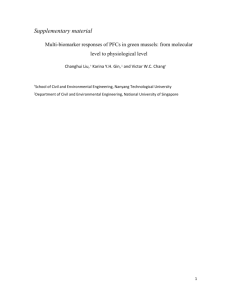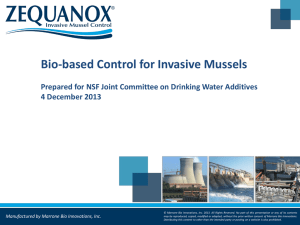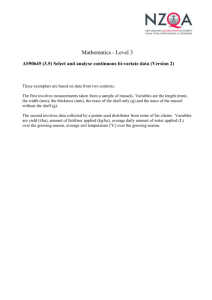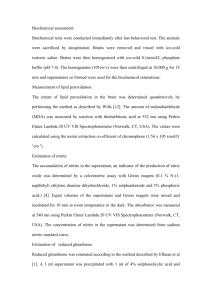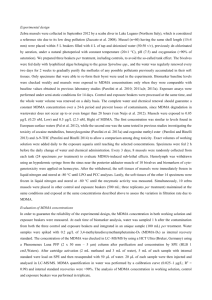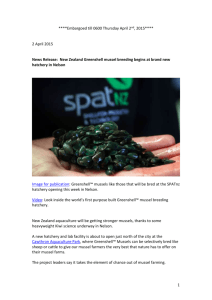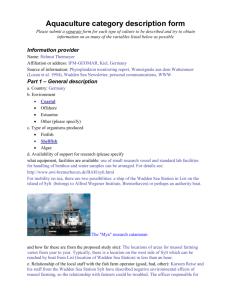etc2306-sm-0001-SuppData
advertisement
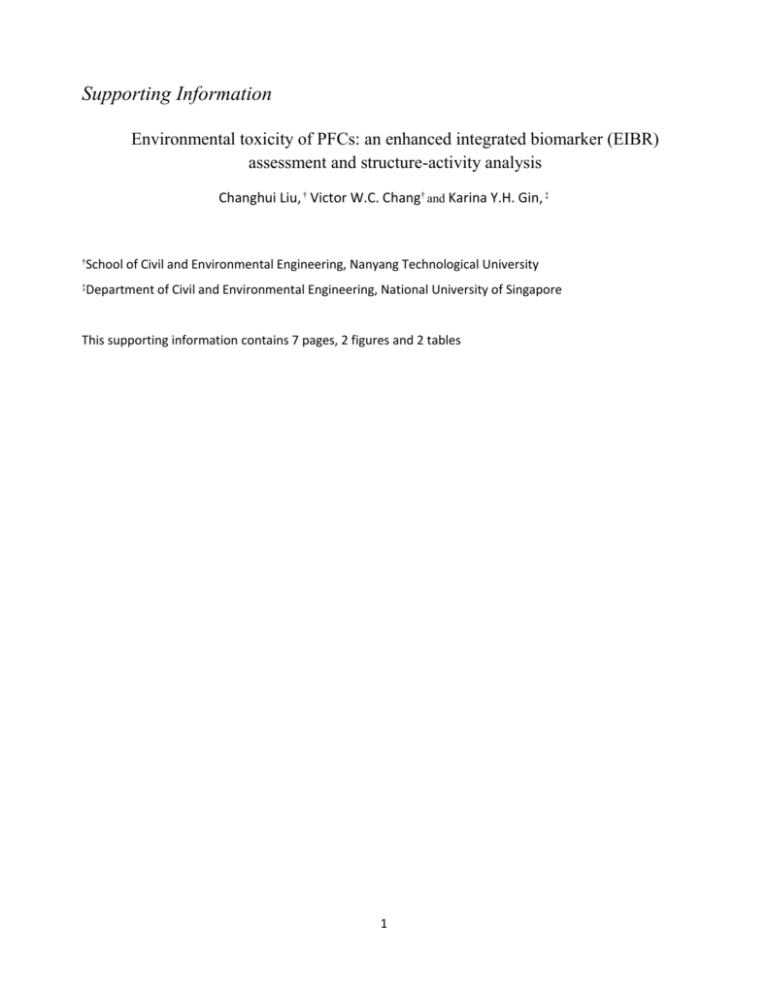
Supporting Information Environmental toxicity of PFCs: an enhanced integrated biomarker (EIBR) assessment and structure-activity analysis Changhui Liu, † Victor W.C. Chang† and Karina Y.H. Gin, ‡ † School of Civil and Environmental Engineering, Nanyang Technological University ‡ Department of Civil and Environmental Engineering, National University of Singapore This supporting information contains 7 pages, 2 figures and 2 tables 1 METHOD Sample preparation Mussel haemolymph was extracted from the anterior adductor muscle with a hypodermic syringe filled with physiological saline solution. The physiological saline solution was prepared by mixing HEPES 4.77 g, NaCl 25.48 g, MgSO4 13.06 g, KCl 0.75 g, CaCl2 1.47 g and distilled water to 1 L. The pH was adjusted to 7.367.5 with NaOH. The haemolymph mixture was then transferred to a microcentrifuge tube. Mussel soft body was cut into pieces and homogenized in 100 nM phosphate buffer (pH7.4, KCl 100 mM, EDTA 1 mM) using a tissue homogenizer. Protease inhibitor (Complete Protease Inhibitor, Roche) was also added. The homogenate was then centrifuged at 500xg for 20 min at 4°C. The supernatant was subsequently transferred into clean tubes and centrifuged again at 2000xg for 30 min at 4°C. Finally the supernatant was ultracentrifuged at 100000xg for 90 min at 4°C. The final supernatant was transferred to clean tubes in ice before analysis. The protein content was quantified using the Bradford protein assay using Bovine Serum Albumin as the standard (Bio-Rad). Biomarker analysis Catalyse (CAT) activity. CAT activity assay was performed using the Catalyse Assay Kit from Cayman Chemical. The method is based on the reaction of the enzyme with methanol in the presence of an optimal concentration of H2O2. CAT activity was determined by measuring the formaldehyde produced colorimetrically with 4-amino-3-hydrazino-5-mercapto-1,2,4-triazole (Purpald) as the chromogen. The reaction was initiated by adding 20 μl of diluted H2O2 to microplate wells with 20 μl of cytosolic extract, 30 μl of methanol and 100 μl assay buffer. After 20 min incubation at 25°C, 30 μl KOH and 30 μl of Purpald were added subsequently. After 10 min incubation, 10 μl of KIO4 was added and the plate was incubated for 5 min before reading the absorbance at 540 nm. The results of CAT activity were expressed in terms of micromole formaldehyde per milligram protein per min. 7-ethoxy resorufin O-deethylase (EROD) activit. To measure EROD activity, mussel gill arches were excised and placed in ice cold HEPES-Cortland buffer (pH 7.7). The tip pieces were isolated by a cut above the septum of the gill filaments which resulted in tips pieces about 2 mm long. For each mussel, 2 mm pieces were selected and groups of ten pieces were placed in microcentrifuge tubes. 0.5 ml of reaction buffer was added and pre-incubated for 10 min. The reaction buffer consisted of 7-ethoxyresorufin (1 μM) and dicumarol (10 μM) in HEPES-Cortland buffer. The reaction buffer was then removed and replaced repeatedly with 0.7 ml fresh reaction buffer with an incubation period of 10 min and 30 min at 25°C. Triplicates of 0.2 ml aliquots were transferred from each tube to a fluorescent 96 well microplate. Resorufin standards (0.5-250 nM) were also included on each plate in triplicates of 0.2 ml aliquots. The standards were 2 diluted from stock solution (10 mM in methanol) using reaction buffer. The fluorescence was determined using a microplate reader at 544 (ex) and 590 (em) nm. The EROD activity was expressed as picomole of resorufin per miligram protein per min. Comet Assay. The Comet assay was performed using the Comet Assay Kit from Cellbiolabs, Inc. The haemolymph suspension was centrifuged at 700xg for 2 min and the supernatant was discarded. The cells were washed and resuspended in ice cold PBS at 1x105 cells/ml. The cell sample was then mixed with preliquified agrose at 1:10 (v/v). 75μl of the mixture was transferred immediately onto microscope slides. The slides were prepared in triplicate for each cell sample. The slides were then transferred to 4°C in the dark for 15 min and maintained horizontally. After gelation, the slides were immersed in ice cold lysis buffer and in ice cold alkaline solution each for 30 min at 4°C in the dark. Electrophoresis was performed in alkaline solution for 30 min at 1 volt/cm, 300 mA. After electrophoresis, the slides were first washed twice in ice cold DI water and then immersed in 70% ethanol for 5 min. 100 μl of Vista Green DNA dye was applied to each slide and incubated at room temperature for 15 min before the slides were observed under epifluorescence microscopy (200x). A total of 500 cells were scored for each sample and the captured images were analyzed using CometScore 1.5 (TriTrek) Neutral red retention time (NRRT). 40 μl of the haemolymph mixture was transferred to a poly-l-lysine coated microscope slide and the slides were immediately placed into a light-proof humidity chamber for 15 min. After incubation, excess haemolymph mixture was removed. 40 μl of neutral red working solution was added to the slides and examined under a light microscope using an x40 objective every 10 min. The neutral red working solution was prepared by mixing neutral red stock solution (20mg/ml in DMSO) with physiological saline at 1:200 (v/v). When not examined, the slides were kept in the humidity chamber. The time at which the best estimate of 50% of the cells showing stress was recorded as the retention time. Filtration rate. The filtration rate was determined as described elsewhere with modifications (Okay and Karacik 2008). The filtration rate was based on the filtration of microalgae by individual mussels in static systems. At the end of the exposure period, mussels were placed separately in 3L plastic tanks with magnetic stirrers. The tanks were filled with 2L of artificial seawater and 200 μl dense algae were added to each tank. The concentration of algae in each tank was determined by a spectrophotometer (750 nm) at 10 min intervals for a total time period of 120 min. The filtration rate of mussels was evaluated as: dC Q C dt (ln C1 ln C2 ) V Q t1 t2 V where V = volume of the tank and Q = filtration rate in L/hour 3 (1) (2) Relative condition factor (RCF). The weight and shell length of mussels were measured at day 0 and 7 of the exposure experiment. The relative condition factor (RCF) was calculated as an indicator of the general well-being of the mussel: RCF W aLb (3) where W is total body weight (in g) and L is shell length (in cm). The parameters a and b were determined from the length-weight relationship (W = aLb) of mussels at day 0 and was used as a constant factor for all individual mussels. The RCF is calculated as the ratio of measured body weight and calculated body weight. This procedure allows the comparison of the condition of each concentration group as well as the control group before and after the exposure. Statistical analysis Data were checked for normality and homogeneity of variance using Kolmogorov Smirnov and Levene’s test. One way ANOVA followed by Tukey’s post-hoc tests were performed to compare variables between the control and the exposure samples. The significance level was set at p<0.05. All statistical analysis was performed using SPSS. 4 CAT ERO D NRR T a. One biomarker has response but star area is zero. CA T NRR T CA T ERO RC D F RC F ERO D NRR T b. Biomarker position and star plot area. Figure S1. Illustration of problems with conventional IBR calculation. 5 Figure S2. Biomarker responses in green mussels exposed to different concentrations of four PFCs. Values represent the mean ± standard error (n = 30). Significant differences (p < 0.05) are marked with *. 6 Table S1 Measured exposure concentration corresponding to nominal concentration. Nominal conc. (μg/L) Control 0.1 1 10 100 1000 PFOS nd 0.12 ± 0.02 1.1 ± 0.1 9.6 ± 0.5 106 ± 10 968 ± 86 PFOA nd 0.08 ± 0.01 1.2 ± 0.05 11.4 ± 0.6 99 ± 8 1120 ± 46 PFNA nd 0.11 ± 0.02 1.1 ± 0.1 10.4 ± 0.4 117 ± 7 1072 ± 27 PFDA nd 0.11 ± 0.03 0.9 ± 0.2 9.9 ± 0.3 89 ± 4 983 ± 10 Values represent the mean ± standard error (n=12). Table S2 PFCs concentration in mussel tissues after 7 days exposure (μg/Kg) Exposure conc. (μg/L) Control 0.1 1 10 100 1000 PFOS nd 13±0.4 124 ± 5 1092±37 3464±25 4186±34 PFOA nd 0.7 ± 0.1 6.5 ± 0.3 58±8 151±12 202±14 PFNA nd 6.4 ± 0.5 64 ± 2 559±19 1758±10 2583±27 PFDA nd 24±0.7 243 ± 11 2106±48 5183±33 6891±101 Values represent the mean ± standard error (n=10). References Okay, O.S.; Karacik, B. Bioconcentration and phototoxicity of selected PAHs to marine mussel Mytilus galloprovincialis. J Environ Sci Health A Tox Hazard Subst Environ Eng 2008; 43:1234-1242. 7
